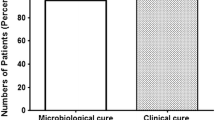Abstract
Piperacillin/tazobactam, at a dosage of 4g/500 mg every 8 h, was administered intravenously to 217 patients with complicated urinary tract infections. The most common diagnosis was pyelonephritis. The most common pathogen wasEscherichia coli (47%) followed byPseudomonas aeruginosa (13%), and enterococci (8%). Among clinically evaluable patients, 86% (115/134) were cured or improved at the study endpoint and 14% (19/134) were clinical failures or relapsed. Among bacteriologically evaluable patients, 85% (95/112) had a favorable clinical response at endpoint. The bacteriological response rate was 73% (82/112) at endpoint. Overall, 82% of all pathogens were eradicated. Therapy was associated with a low incidence of side effects, and adverse experience were mild and of short duration.
Similar content being viewed by others
References
Cooksey R, Swenson J, Clark N, Gay E, Thornsberry C (1990) Patterns and mechanisms of β-lactam resistance amongst isolates ofEscherichia coli from hospitals in the United States. Antimicrob Agents Chemother 34:739–745
Eliopoulos GM, Klimm K, Ferraro MJ, Jacoby GA, Moellering RC Jr (1989) Comparative in vitro activity of piperacillin combined with the beta-lactamase inhibitor tazobactam (YTR 830). Diagn Microbiol Infect Dis 12:481–488
Fortner CL, Finley RS, Schimpff SC (1982) Piperacillin sodium: antibacterial spectrum, pharmacokinetics, clinical efficacy, and adverse reactions. Pharmacotherapy 2:287–299
Gooding PG, Clark BJ, Sathe SS (1982) Piperacillin: a review of clinical experience. J Antimicrob Chemother 9 [Suppl B]:93–99
Gutmann L, Kitzis MO, Yamabe S, Acar JF (1986) Comparative evaluation of a new beta-lactamase inhibitor, YTR 830, combined with different beta-lactam antibiotics against bacteria harboring known beta-lactamases. Antimicrob Agents Chemother 29:955–957
Jacoby GA, Sutton L (1985) β-lactamases and β-lactam resistance inEscherichia coli. Antimicrob Agents Chemother 28:703–706
Kuck NA, Jacobus NV, Peterson PJ, Weiss WJ, Testa RA (1989) Comparative in vitro and in vivo activities of piperacillin combined with the β-lactamase inhibitors tazobactam, clavulanic acid, and sulbactam. Antimicrob Agents Chemother 33:1964–1969
Kwung P, Fu H, Neu C (1978) Piperacillin, a new penicillin active against many bacteria resistant to other penicillins. Antimicrob Agents Chemother 358–367
Sabath LD, Elder HA, McCall CE, Finland M (1976) Synergistic combinations of penicillins in the treatment of bacteriuria. N Engl J Med 277:232–238
Author information
Authors and Affiliations
Rights and permissions
About this article
Cite this article
Nowé, P. Piperacillin/tazobactam in complicated urinary tract infections. Intensive Care Med 20 (Suppl 3), S39–S42 (1994). https://doi.org/10.1007/BF01745250
Issue Date:
DOI: https://doi.org/10.1007/BF01745250




